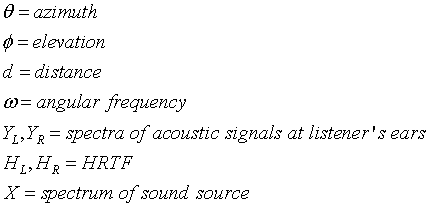

|
| Home < About AuSIM < Technology < Primers < Audio Perception pg1 < Audio Perception pg2 | ||||
|
Primers
Auditory Perception - Page 2, HRTFs |
||||
|
Head-Related Transfer Function
There is an additional acoustic cue that helps to resolve the position on a cone of confusion. Before reaching the listener’s ears, the acoustic waves emitted by a source are filtered by the interaction with the listener’s head, torso and the pinnae. This results in a directionally dependent spectral coloration of the sound. This systematic “distortion” of a sound’s spectral composition acts as a unique fingerprint defining the location of a source. The auditory system uses this mapping between spectral coloration and physical location to disambiguate the points found on a cone of confusion, thus enabling accurate localization of a sound source. |
The composite of the ITD, ILD and the spectral coloration characteristics are captured in Head-Related Transfer Functions (HRTF). The HRTF, Figure 2, is the frequency-domain representation of the Head-Related Impulse Response (HRIR), Figure 3. Even though HRTF’s are very rich in acoustic information, perceptual research shows that the auditory system is selective in the acoustic information that it uses in making judgments of the originating direction of a sound source. |
|||

Figure 2 - Head-Related Impulse Response of KEMAR, right ear, 0° elevation ring. |

Figure 3 - Head-Related Transfer Function of KEMAR, right ear, 0° elevation ring |
|||
|
Due to physical differences between individuals,
HRTFs vary greatly in both general shapes and detail.
As a result, serious perceptual distortions can occur
while listening using HRTF’s that were either synthesized or measured on another individual.
Nevertheless, research shows some individuals’ experience
equaled, even improved, localization accuracy with non-individualized HRTFs – especially when HRTFs of a
“good localizer” are used.
In general, the relationship between the sound source and the signal reaching a listener’s ears can be represented by:    |
The extraction of the HRTF is performed by cross-correlating the input signal with the
resulting output.
The system response is defined by:
 
The process of localizing a sound source can thus be described as the extraction of
|
|||
| << Go Back to Page 1 - Localization Continues on Page 3 - Motion Cues Return to Primers >> | ||||
|
|
||

|
[Home] [About AuSIM] [Products] [Services] [Applications] |
|
| [Support] [Contacts] [Buy Online] [Downloads] [News & Events] | ||
| © AuSIM Inc. 1998-2011. Last updated on | ||